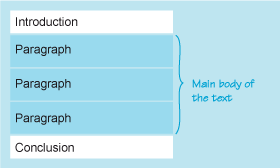1.3 What academic sources look like
Academic and specialist sources, such as the ones you have just considered, may have different purposes and contain different kinds of information but they all aim to present content in a clear way. This is why they all follow a clear and predictable structure.
The structure of each type of source depends on its purpose. For example, to help readers to find a specific term easily and quickly, dictionaries arrange words and their definitions in alphabetical order. Once readers understand the way the words are listed, looking up a word is not difficult.
Academic articles or book chapters also follow a clear and predictable structure. They normally contain an introduction, several paragraphs and a conclusion. Paragraphs may also be grouped into sections. This is their typical structure:
Activity _unit2.1.3 Activity 3
The components of a typical article or book chapter are listed below. Match each component to its definition.
Two lists follow, match one item from the first with one item from the second. Each item can only be matched once. There are 4 items in each list.
-
Paragraph
-
Conclusion
-
Introduction
-
Main body of the text
Match each of the previous list items with an item from the following list:
a.Summarises the content of the main body of the text.
b.Discusses one specific topic.
c.Mentions the text’s content and organisation.
d.Contains paragraphs and sections.
- 1 = b,
- 2 = a,
- 3 = c,
- 4 = d
In this section you have seen how dictionaries, chapters and journal articles are organised. Other texts such as newspaper articles, web pages and fact sheets are organised differently. If you enrol on a university course, you will gradually learn to recognise the specific structure of different texts and this knowledge will help you when you read academic texts.

